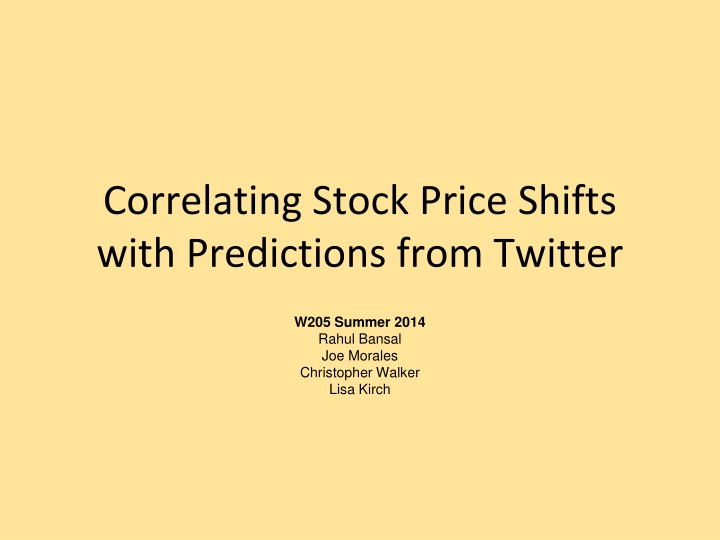
Correlating Stock Price Shifts with Twitter Predictions for Financial Analysis
Explore the correlation between stock price shifts and sentiment predictions from Twitter data for S&P 500 companies. Utilize tools like Python, Solr, and Hadoop platform for sentiment analysis and data processing.
Download Presentation

Please find below an Image/Link to download the presentation.
The content on the website is provided AS IS for your information and personal use only. It may not be sold, licensed, or shared on other websites without obtaining consent from the author. If you encounter any issues during the download, it is possible that the publisher has removed the file from their server.
You are allowed to download the files provided on this website for personal or commercial use, subject to the condition that they are used lawfully. All files are the property of their respective owners.
The content on the website is provided AS IS for your information and personal use only. It may not be sold, licensed, or shared on other websites without obtaining consent from the author.
E N D
Presentation Transcript
Correlating Stock Price Shifts with Predictions from Twitter W205 Summer 2014 Rahul Bansal Joe Morales Christopher Walker Lisa Kirch
Project Idea 271 million active Twitter users monthly and 500 million tweets sent daily => a fairly sizable corpus of sentiment is available for analysis. Downside Hedge , Dataminr, et al doing targeted financial sentiment analysis The End of Theory: The Data Deluge Makes the Scientific Method Obsolete http://archive.wired.com/science/discoveries/magazine/16-07/pb_theory All models are wrong, and increasingly you can succeed without them. - Peter Norvig, Director of Research at Google
Project Overview Gather Tweets Score/Filter By Sentiment Score/Filter by Relevance to S&P 500 Companies Correlate to Stock Price
Tools and Methods Purpose Tools Used Code Base Github - https://github.com/jmorales4/W205-RJCL Version Control SourceTree by Atlassian Storage S3 - http://rjcl-tweets.s3.amazonaws.com/ http://rjcl-stockquotes.s3.amazonaws.com/ http://10k-clean-data.s3.amazon.com Twitter Sentiment Analysis Python sentiment analysis courtesy Alex Davies http://alexdavies.net/ Search / Relevance Scoring Apache Solr Hadoop Platform Amazon Elastic MapReduce Hadoop streaming using Python Languages Python (with tweepy, boto, BeautifulSoup, numpy, and solrpy) Perl R APIs Twitter Solr Yahoo Finance Other XML JSON Tableau
Company Information System Selected the S&P 500 Companies Form 10-K: annual reports containing text data describing each company (business, products, services, officers, etc.) Beautiful Soup: clean and parse data Upload to Apache Solr running on EC2
Solr Evolution and Demo Facets matched to our metadata, lots of search options Tweets are very hard to parse for specific metadata elements Why search metadata when the main document text already contains it? API test harness Natural search vs. explicit OR: OR returned results reliably Load/Performance concerns: t2.micro vs. m3.large
Stock Price Data Flow Every 10 minutes, get stock prices from Yahoo Finance API Store on Amazon S3: 468 files (37 MB) Map step: parse stock data, round to nearest 10 minute Reduce step: emit CSV for analysis with Twitter data Analyze in R
Tweet Data Flow Twitter firehose: 5700 TPS average Twitter sample stream: 67 TPS average Amazon S3: 90m tweets total (269 GB) 30m tweets in period of interest (8/4 8/9) Map step 1: sentiment score, filter neutral tweets Map step 2: relevance score, filter irrelevant tweets Reduce step: aggregate scores by company and time (10 min buckets) Combine with stock price data and output as CSV Analyze in R
Top 10 Companies on Twitter Based on Tweets collected and scored against company 10-Ks during the week of August 4th through August 8th
Correlating Price Shift and Tweet Shift We started by looking at correlation of price shifts and predicted Twitter shifts at a 10-minute interval Looking at the data at this level did not produce any significant correlation. Next we decided to roll up the shifts at the hourly level.
Correlating Price Shift and Tweet Shift Looking at correlation of price shifts and predicted Twitter shifts at an hourly interval Looking at the data at this level did not produce any significant correlation either. Next we decided to roll up the shifts at the day level.
Correlating Price Shift and Tweet Shift Looking at correlation of price shifts and predicted Twitter shifts at the day interval Looking at the data at this level does produce a strong correlation but with such a small sample size. We need more data to conclude anything at the day level. Negative correlation indicating positive tweets result in negative price shifts.
Correlating Price Shift and Tweet Shift Finally, we looked whether there was a correlation between price shifts 10 minutes after predicted Tweet shifts. This would indicate a lag in market reaction time. No real correlation evident with this 10-minute shift.
Lessons Learned Number of tweets captures were a small part of the Twitterverse. The sentiment package used did not produce reliable scores. Solr relevance scores did not always make intuitive sense (e.g., searching for Big Mac yielded McDonald s as the 3rd most relevant company with a relevance score that was <1% of the relevance score of the top relevant company, Macerich). Financial markets are open 9:30 AM - 4 PM ET, but people tweet 24 hours a day. Need a better way to capture correlations (perhaps include Asian market data). Due to time constraints, we only have one week of stock quote data processed. Perhaps trends would become more apparent over a longer period of data.
